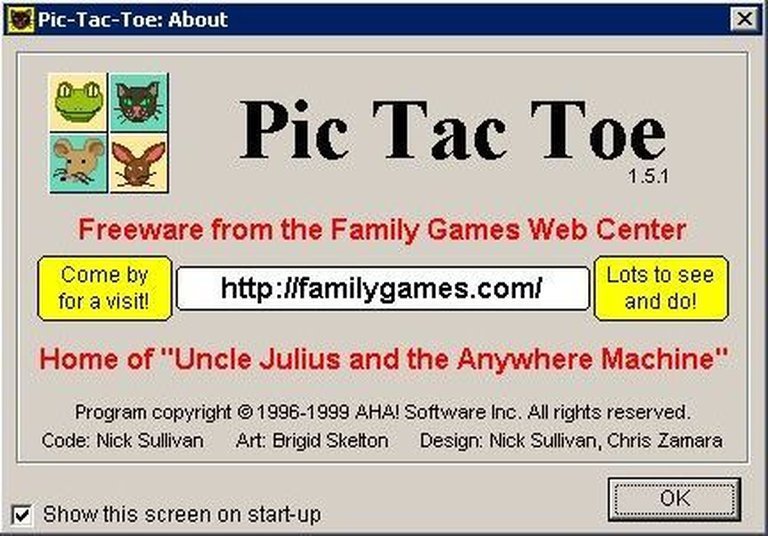- Release Year: 1999
- Platforms: Windows
- Publisher: Family Games Freeware
- Developer: AHA! Software Inc.
- Genre: Paper-and-pencil game – Tic-Tac-Toe, Strategy, Tactics
- Perspective: Top-down
- Game Mode: Hotseat, Single-player
- Gameplay: Turn-based

Description
Pic Tac Toe is a freeware strategy game combining elements of Tic-Tac-Toe and Connect Four with picture-based gameplay. The game is played on a 4×4 grid where each cell is divided into four smaller squares, each containing three or four pictures. Players take turns clicking on individual pictures to change them to their color. There are three distinct victory conditions: filling all four pictures in a single cell, forming a line of four pictures in the same relative position across cells (horizontally, vertically, or diagonally), or creating a line of four identical pictures regardless of their positions within the cells.
Pic Tac Toe Free Download
PC
Pic Tac Toe: A Retrospective Analysis of a Quirky Strategy Game
Introduction
Released on October 16, 1999, for Windows, Pic Tac Toe is a freeware strategy game that combines elements of Tic-Tac-Toe and Connect Four, played with a unique twist: pictures within a grid. Developed by AHA! Software Inc. and published by Family Games Freeware, this game has remained relatively obscure despite its innovative gameplay mechanics. This review aims to provide an in-depth analysis of Pic Tac Toe, exploring its development history, gameplay, and legacy to assess its significance in the world of video games.
Development History & Context
Pic Tac Toe was created by a team of three individuals: Nick Sullivan, who handled coding and design; Brigid Skelton, responsible for the game’s art; and Chris Zamara, who contributed to the game’s design. The development studio, AHA! Software Inc., was involved in creating educational and family-friendly content, as evidenced by their other titles such as Santa’s Secret Valley and Uncle Julius and the Anywhere Machine. The late 1990s saw a surge in casual and freeware games, and Pic Tac Toe fits into this niche, offering a unique blend of strategy and visual appeal.
The technological landscape of the late 1990s allowed for the creation of games with more sophisticated graphics and gameplay mechanics than in previous years. Pic Tac Toe leverages this by using a point-and-click interface and a visually engaging grid-based system. The game’s release as freeware also made it accessible to a wide audience, bypassing traditional commercial barriers.
Narrative & Thematic Deep Dive
Pic Tac Toe does not have a traditional narrative. Instead, its focus is on the gameplay experience, presenting a straightforward strategy game where players compete against each other or against the computer. The game’s thematic elements are minimal, with the primary theme being the competition inherent in playing games like Tic-Tac-Toe and Connect Four. The use of pictures within the grid adds a layer of visual interest, but the game does not have a deeper narrative or thematic resonance.
Gameplay Mechanics & Systems
The gameplay of Pic Tac Toe is its most distinctive feature. Played on a 4×4 grid, where each cell is further divided into four smaller sections containing different pictures, players take turns clicking on one of these smaller pictures to change its color to their own. Winning conditions are met in one of three ways: changing all four pictures in a cell to the player’s color, creating a line of four pictures that are in the same relative position within their cells, or creating a line of four identical pictures.
The game’s turn-based system and point-and-click interface make it simple to understand and play, accessible to a wide range of players. The combination of the three winning conditions adds depth and requires strategic thinking, as players must balance immediate goals with long-term strategies.
World-Building, Art & Sound
The visual design of Pic Tac Toe is notable for its use of colorful pictures within the grid, making the game visually appealing, especially for a title released in 1999. The art style is straightforward and family-friendly, aligning with the game’s overall tone. While specific details about the sound design are not available, the lack of mention of sound effects or music suggests that it may not be a significant component of the game’s experience.
The game’s world-building is essentially nonexistent, given its abstract nature. The grid and the pictures within it are the entirety of the game’s “world,” which is presented in a clean and functional manner.
Reception & Legacy
Upon its release, Pic Tac Toe did not garner significant critical attention, as evidenced by the lack of critic reviews on platforms like Metacritic for the original Windows version. However, its release as freeware allowed it to reach a wider audience. A later iOS version, developed and published by Ryan DeVore in 2009, categorized it under “Edutainment,” suggesting an attempt to rebrand or reposition the game for a different audience.
The legacy of Pic Tac Toe is not one of broad cultural impact or influence on the wider gaming industry. Instead, it remains a niche title, appreciated by those who encountered it during its initial release or later through digital archives. Its innovative blend of gameplay mechanics and accessible design makes it a notable, if not influential, entry in the history of strategy games.
Conclusion
Pic Tac Toe is a unique strategy game that, despite its obscurity, offers an engaging and challenging experience. Its combination of Tic-Tac-Toe and Connect Four elements, played with pictures on a grid, presents a fresh twist on classic gameplay mechanics. While it may not have had a significant impact on the gaming industry or received widespread critical acclaim, Pic Tac Toe remains an interesting footnote in the history of video games, showcasing the creativity and diversity of late 1990s game development.
In conclusion, Pic Tac Toe is worth revisiting for its originality and as a representative of the freeware and casual gaming scene of the late 1990s. Its place in video game history is secured as a curiosity and an example of the innovative approaches to gameplay that were explored during this period.